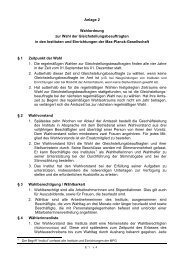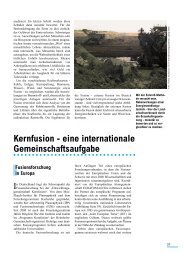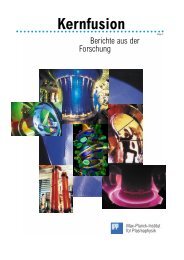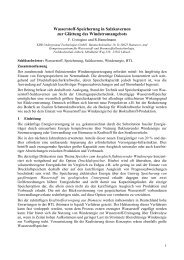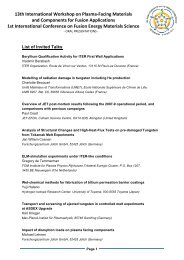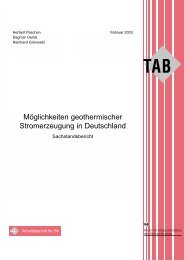IPP Annual Report 2007 - Max-Planck-Institut für Plasmaphysik ...
IPP Annual Report 2007 - Max-Planck-Institut für Plasmaphysik ...
IPP Annual Report 2007 - Max-Planck-Institut für Plasmaphysik ...
You also want an ePaper? Increase the reach of your titles
YUMPU automatically turns print PDFs into web optimized ePapers that Google loves.
20 channels each which are collimated by two separate slitapertures<br />
in order to achieving the required wide viewing<br />
angle view. A first design of the water cooled aperture plate<br />
and detector holder has been completed. FE calculations<br />
(ANSYS) of these designs are presently being performed<br />
to evaluate the temperature of the camera components for<br />
W7-X steady state operation conditions (~50 kW/m 2 ). A<br />
study of the neutral pressure sensitivity of the metal foil<br />
detectors has shown that blind-channels need to be integrated<br />
into the design of the bolometer cameras to monitor this<br />
effect. The detailed design of the video diagnostics – which<br />
is being developed by KFKI-RMKI Budapest – was finished<br />
in <strong>2007</strong>. For the video observation the 10 equivalent<br />
tangential AEQ-ports of the W7-X vacuum vessel will be<br />
used giving nearly full coverage of the entire plasma vessel.<br />
In the elaborated design the Sensor Module (SM) of the<br />
Event Detection Intelligent Camera (EDICAM) is located at<br />
the plasma end of the ports. The mechanics that transports<br />
and docks the camera capsule – containing the SM to the<br />
front window was manufactured and its mechanical and<br />
thermal tests will be completed in 2008. Also the design of<br />
the diagnostic front end, consisting of an air – vacuum<br />
window, a small shutter and a water cooled plasma facing<br />
front plate with a pinhole for plasma observation has been<br />
completed by <strong>IPP</strong> Greifswald. The manufacturing of the<br />
prototype is still ongoing. Radiation resistance test had been<br />
performed on the first version of the Sensor Module. The<br />
current version of the SM consists of only the essential electronics<br />
in order to allow testing the performance of the<br />
CMOS sensor itself, without the possible influence from a<br />
more complex electronics. The SM was irradiated at different<br />
gamma (between 0.1 Gy/h and 5 Gy/h) and fast neutron<br />
(between 0.7 Gy/h and 1.4 Gy/h) dose rates in fission<br />
research reactors. The evaluation of the images obtained<br />
during the gamma irradiation test shows no enduring damage<br />
on the CMOS sensor. Gammas cause only short time<br />
flashing of the effected pixels. During the neutron irradiation<br />
test the SM absorbed about 60 Gy total dose (about the<br />
quadruple of the expected upper limit of the annual dose at<br />
W7-X) revealing a clear increase of the dark current of the<br />
individual pixels with increasing accumulated dose, but it<br />
still remained functional. The development of the EDICAM<br />
Image Processing and Controlling Unit (IPCU) and 10 Gbit<br />
fibre link connecting the SM to the IPCU advances according<br />
to the plans. The hardware kit for the IPCU (FPGA development<br />
board with PCI express PC connector, ALTERA)<br />
was purchased. The 10 Gbit fibre link is expected to be ready<br />
in 2008.<br />
7.2.5 Thomson Scattering<br />
The design of a polychromator prototype for analysing the<br />
scattered light was continued and successfully tested at<br />
ASDEX-Upgrade. A water cooled shutter was designed, to<br />
Wendelstein 7-X<br />
53<br />
protect the vacuum window in front of the observation port.<br />
A design study for the observation optics has been performed<br />
with the optical design program ZEMAX.<br />
7.2.6 Soft X-Ray and Magnetic Diagnostics<br />
The design for the integration of the in-vessel X-ray tomography<br />
camera system (XMCTS) beneath the heat protection<br />
roof (designed by KiP) has been finalised. The camera<br />
design including the cooling is completed and finite element<br />
calculations were performed proving the effectiveness of the<br />
cooling with respect to the expected heat fluxes. Several<br />
components for the XMCTS are being manufactured for<br />
prototype testing. Notably, the vacuum feed-through connectors<br />
between the photo diode array and the electronic<br />
box have been designed and manufactured by the company<br />
Schott. The shutter prototype (protecting the photo diodes<br />
during glow discharges and allowing for offset drift correction<br />
during long discharges) was tested. Its mechanical<br />
design is based on a pressurised manometer tube spring<br />
attached to a lid. It was demonstrated that the shutter is<br />
capable of more than 100,000 cycles under vacuum conditions<br />
with additional heating cycles. The robustness of the<br />
design is therefore sufficient, but small improvements are to<br />
be considered for optimal operation in the W7-X vessel. The<br />
continuation of the work on the preamplifiers was very difficult<br />
throughout the year due to the lack of manpower in the<br />
Greifswald electronics department. The cross-talk problem<br />
between channels has been overcome to a large extent. One<br />
of the main tasks in 2008 will be the test of a preamplifier<br />
board fitted into the vacuum-tight electronic box. Further<br />
major tasks in 2008 are the in-vessel cable routing and the<br />
assembly of a prototype camera. The legacy code for the<br />
tomographic inversion of W7-AS SX-ray data is being ported<br />
from a specific AIX/W7-AS environment to a general Linux<br />
version, which will be advantageous with respect to the<br />
processing speed and portability. The code was simplified,<br />
generalized and optimised and converted to a more consistent<br />
and object-oriented design. The long discharge<br />
lengths of W7-X pose a severe challenge to the data analysis<br />
task. The amount of data from the XMCTS system in continuous<br />
acquisition for a 30 min discharge sums up to about<br />
500 GBytes. A method for an online method giving information<br />
on the plasma shape and possibly mode onsets on a<br />
human time scale is desirable. One approach to this challenge<br />
involves the application of neural networks, which are<br />
real time capable after a time-consuming training phase.<br />
This work was done in collaboration with IST and <strong>IPP</strong><br />
Garching. First results were presented on the Plasma <strong>2007</strong><br />
conference. The collaboration contract with the <strong>IPP</strong>LM in<br />
Warsaw on X-ray pulse height analysis and on an electron<br />
temperature monitor system based on the filter foil method<br />
has to be extended. The main focus in <strong>2007</strong> was on the layout<br />
of the filter system and on suitable data analysis algorithms.






